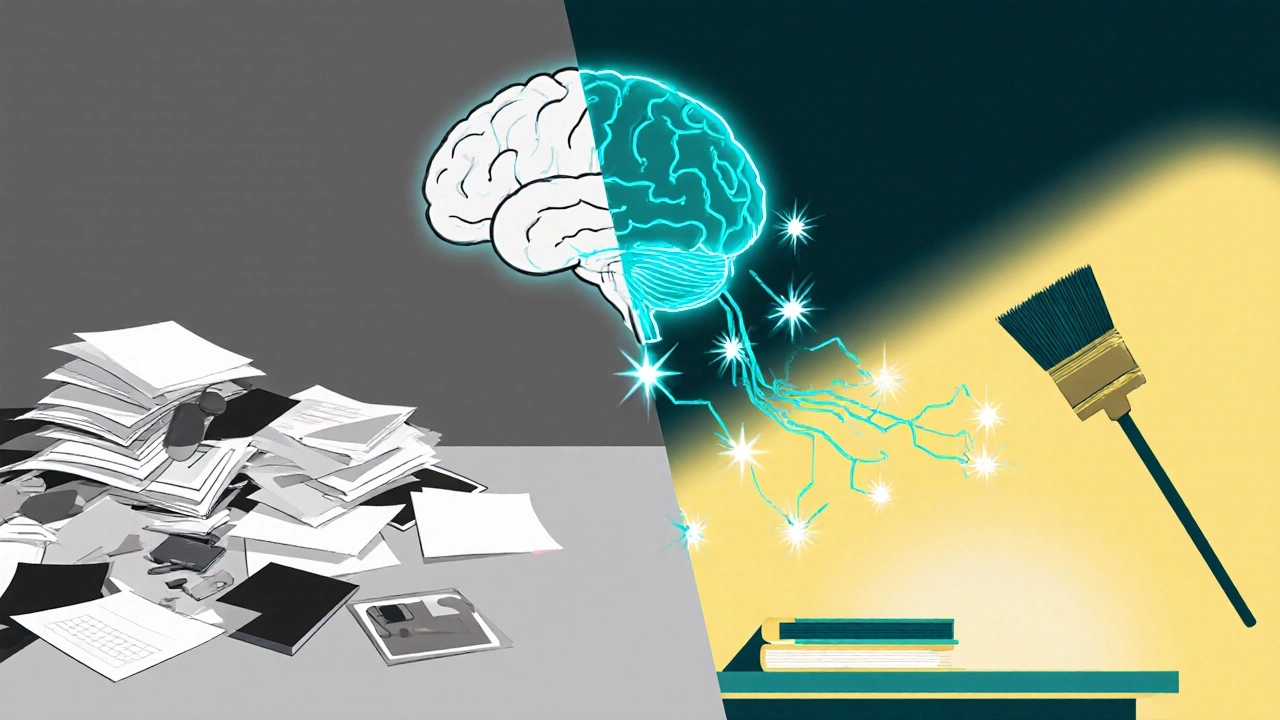When you hear the phrase Spring cleaning is a seasonal deep‑cleaning ritual that many people undertake to refresh their homes as the weather warms, you might think it’s just a chore. In fact, a bundle of mental tricks push us to open closets, move furniture and scrub windows every few months.
Why the urge spikes when the calendar flips to spring
The timing isn’t random. Seasonal affective disorder is a mood shift that many experience as daylight increases, leading to higher energy and a desire for change (a mild form of SAD). Your brain registers the extra sunshine as a cue that it’s time to reset, both physically and mentally.
Clutter and the brain: How mess messes with your thoughts
Living in a cluttered space taxes the Cognitive load theory which says our working memory can only hold a limited amount of information at once. Too many items on a table compete for attention, making it harder to focus on tasks. By clearing the visual noise, you free up mental bandwidth.
There’s also a chemical side. Dopamine acts as the brain’s reward messenger and spikes when we finish a tidy‑up task. That little rush reinforces the behavior, turning a one‑off spring purge into a habit you look forward to.
Habit formation and the "fresh‑start" effect
Psychologists call the spring period a Fresh‑start effect the tendency to begin new habits when temporal landmarks signal a new chapter. The calendar itself becomes a motivational cue. Combine that with Behavioral economics’s idea of "mental accounting" - we treat the new season as a separate budget for effort, making it feel affordable to invest energy in cleaning.
Forming a cleaning habit follows the classic loop: cue (spring arrives), routine (deep clean), reward (dopamine hit). Repeating this loop for a few years cements the behavior into an automatic response.

Decision fatigue and the power of a clean slate
When you walk into a messy room, you’re forced to make countless micro‑decisions - where to put a stack of papers, how to sort laundry, whether to dust the shelf. Decision fatigue is the mental drain that results from too many choices. By tackling the mess early in the season, you reduce the number of daily decisions, freeing up willpower for other goals.
Emotional payoff: Feeling good about your space
Beyond the brain chemistry, a clean home satisfies deeper psychological needs. Maslow's hierarchy of needs places safety and belonging near the bottom, but a tidy environment reinforces both; you feel safe because hazards are removed, and you feel a sense of belonging as the space reflects your standards.
Cleaning also activates Positive reinforcement the process where a pleasant outcome strengthens a behavior. When you step back and see sparkling windows, the pleasure reinforces the decision to clean again next year.
Practical ways to use psychology in your spring clean
- Set a clear cue. Mark the start of spring on your calendar and treat it as a non‑negotiable appointment.
- Break the task into small rituals. Instead of "clean the whole house," schedule 30‑minute sessions for each room. Small wins keep dopamine flowing.
- Use music or a podcast. Auditory stimulation reduces perceived effort and makes the routine more enjoyable, boosting the reward signal.
- Visualize the result. Imagine the calm of a decluttered living room before you start. Visualization primes the brain for the upcoming reward.
- Reward yourself immediately. After each room, do something pleasant - a cup of tea, a short walk, or a five‑minute social media scroll.
- Apply the "one‑in, one‑out" rule. For every new item you bring home, discard an old one. This prevents clutter from rebuilding.
- Leverage social accountability. Share your cleaning goals with a friend or post progress on social media. Knowing someone’s watching adds a mild external pressure that boosts compliance.

Quick checklist for a psychology‑backed spring clean
- Mark the first Saturday of March as "Spring Clean Day" on your calendar.
- Gather three bins: Keep, Donate, Trash.
- Start with a high‑traffic area (kitchen or living room) for the fastest dopamine boost.
- Play a playlist that matches your cleaning tempo (120‑130 BPM works well).
- Set a timer for 30 minutes per room; stop when it rings.
- Take a 5‑minute break after each session; sip water, stretch.
- Document the before‑and‑after photos; review them for positive reinforcement.
Comparison of Motivation Types Behind Spring Cleaning
| Motivation | Core Driver | Typical Trigger | Resulting Behavior |
|---|---|---|---|
| Intrinsic | Personal satisfaction & mental clarity | Feeling of clutter fatigue | Regular decluttering without external pressure |
| Extrinsic | Social approval or seasonal expectations | Friends posting about clean homes, media articles | Cleaning to meet perceived standards |
| Temporal | Fresh‑start effect | New season, calendar marker | One‑off deep clean at the season’s start |
| Reward‑based | Dopamine release | Visible progress (e.g., sparkling windows) | Repeating cleaning to chase the dopamine hit |
Frequently Asked Questions
Why does cleaning feel more rewarding in spring?
Longer daylight boosts serotonin and signals a natural reset, so finishing a clean space releases extra dopamine, making the effort feel worthwhile.
Can I apply spring‑cleaning psychology year‑round?
Absolutely. Use the same cues - set a calendar reminder, break tasks into small wins, and reward yourself - whenever you need a mental reset.
How does clutter affect my decision‑making?
Clutter overloads visual processing, consuming working‑memory capacity. This leads to poorer choices and increased decision fatigue.
What’s the "one‑in, one‑out" rule?
For every new item you bring home, you discard or donate an existing one. It keeps the total number of possessions steady and prevents future clutter.
Is there a best time of day for cleaning?
Mid‑morning, after a light breakfast, works for most people. Energy levels are high, daylight is natural, and the dopamine boost from early progress sets the tone for the day.




